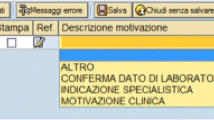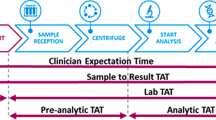Abstract
Quality can be defined as the ability of a product or service to satisfy the needs and expectations of the customer. Laboratories are more focusing on technical and analytical quality for reliability and accuracy of test results. Patients and clinicians however are interested in rapid, reliable and efficient service from laboratory. Turn around time (TAT), the timeliness with which laboratory personnel deliver test results, is one of the most noticeable signs of laboratory service and is often used as a key performance indicator of laboratory performance. This study is aims to provide clue for laboratory TAT monitoring and root cause analysis. In a 2 year period a total of 75,499 specimens of outdoor patient department were monitor, of this a total of 4,142 specimens exceeded TAT. With consistent efforts to monitor, root cause analysis and corrective measures, we are able to decreased the specimens exceeding TAT from 7–8 to 3.7 %. Though it is difficult task to monitor TAT with the help of laboratory information system, real time documentation and authentic data retrievable, along with identification of causes for delays and its remedial measures, improve laboratory TAT and thus patient satisfaction.

Similar content being viewed by others


References
Hilborne LH, Oye RK, McArdle JE, Repinski JA, Rodgerson DO. Evaluation of stat and routine turnaround times as a component of laboratory quality. Am J Clin Pathol. 1989;91(3):331–5.
Howanitz PJ, Cembrowski GS, Steindel SJ, Long TA. Physician goals and laboratory test turnaround times. a college of American Pathologists Q-Probes study of 2763 clinicians and 722 institutions. Arch Pathol Lab Med. 1993;117(1):22–8.
Novis DA, Dale JC. Morning rounds inpatient test availability: a college of American Pathologist Q-Probes study of 79860 morning complete blood cell count and electrolyte test results in 367 institutions. Arch Pathol Lab Med. 2000;124(4):499–503.
Valenstein P. Laboratory turnaround time. Am J Clin Pathol. 1996;105(6):676–88.
Sinreich D, Sinreich D, Marmor Y. J Health Organ Manag. 2005;19(2):88–105.
Holland LL, Smith LL, Blick KE. Reducing laboratory turnaround time outliers can reduce emergency department patient length of stay: an 11-hospital study. Am J Clin Pathol. 2005;124(5):672–4.
Gelrud J, Burroughs H, Koterwas J. Emergency care center turnaround time–an improvement story. J Healthc Qual. 2008;30(1):31–7.
Derlet RW, Richards JR. Overcrowding in the nation’s emergency departments: complex causes and disturbing effects. Ann Emerg Med. 2000;35(1):63–8.
Hawkins RC. Laboratory turnaround time. Clin Biochem Rev. 2007;28(4):179–94.
Westbrook JI, Georgiou A, Rob MI. Computerized order entry systems: sustained impact on laboratory efficiency and mortality rates? Stud Health Technol Inform. 2008;136:345–50.
Georgiou A, Williamson M, Westbrook JI, Ray S. The impact of computerized physician order entry systems on pathology services: a systematic review. Int J Med Inform. 2007;76(7):514–29.
Steindel SJ, Jones BA, Howanitz PJ. Timeliness of automated routine laboratory tests: a college of American Pathologist Q - Probes study of 653 institutions. Clin Chim Acta. 1996;251(1):25–40.
Steindel SJ, Howanitz PJ. Physician satisfaction and emergency department laboratory test turnaround time. Arch Pathol Lab Med. 2001;125(7):863–71.
Manor PG. Turnaround times in the laboratory: a review of the literature. Clin Lab Sci. 1999;12(2):85–9.
Rollo JL, Fauser BA. Computers in total quality management. Statistical process control to expedite stats. Arch Pathol Lab Med. 1993;117(9):900–5.
Bilwani F, Siddiqui I, Vaqar S. Determination of delay in Turnaround Time (TAT) of stat test and its causes: AKUH experience. J Pak Med Assoc. 2003;53(2):65–7.
Steindel SJ, Novis DA. Using outlier events to monitor test turnaround time. a college of American Pathologist Q - Probe study in 496 laboratories. Arch Pathol Lab Med. 1999;123(7):607–14.
Chung HJ, Lee W, Chun S, Park HI, Min WK. Analysis of turnaround time by subdividing three phases for outpatient chemistry specimens. Ann Clin Lab Sci. 2009;39(2):144–9.
Fernandes CM, Worster A, Eva K, Hill S, McCallum C. Pneumatic tube delivery system for blood samples reduces turnaround times without affecting sample quality. J Emerg Nurs. 2006;32(2):139–43.
Saxena S, Wong ET. Does the emergency department need a dedicated stat laboratory? Continuous quality improvement as a management tool for the clinical laboratory. Am J Clin Pathol. 1993;100(6):606–10.
Conflict of interest
None.
Author information
Authors and Affiliations
Corresponding author
Rights and permissions
About this article
Cite this article
Chauhan, K.P., Trivedi, A.P., Patel, D. et al. Monitoring and Root Cause Analysis of Clinical Biochemistry Turn Around Time at an Academic Hospital. Ind J Clin Biochem 29, 505–509 (2014). https://doi.org/10.1007/s12291-013-0397-x
Received:
Accepted:
Published:
Issue Date:
DOI: https://doi.org/10.1007/s12291-013-0397-x


